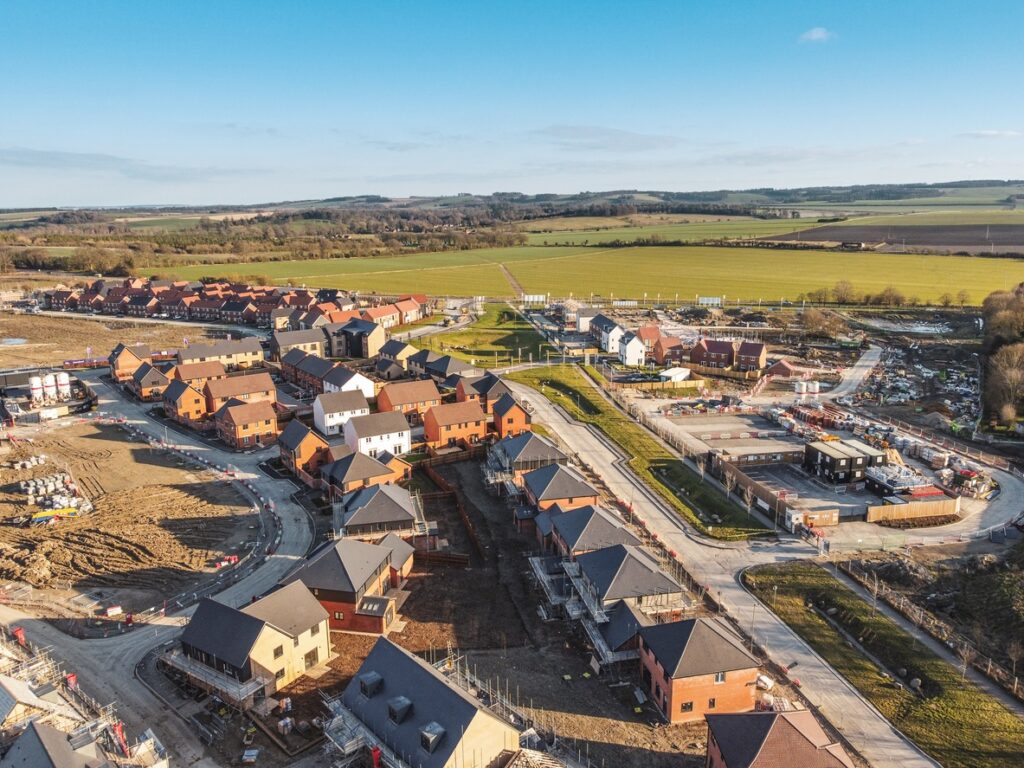
Planning pundits have been busy since the new NPPF was published on 12 December 2024 and much has been written about it. Here we update our piece on the July 2024 NPPF consultation, Planning Reforms – Reasons to be Cheerful, by my colleague Stephen Webb with the changes introduced by the new NPPF. Many of the proposals have been carried forward and the wind is still firmly blowing in a pro-development direction. So, what has happened?
Housing targets – It is now a mandatory requirement for local housing need to be calculated using the revised standard method set out in the Planning Practice Guidance (PPG) (paragraph 62 of the NPPF). This uses a formula that incorporates a baseline of local housing stock levels, to better reflect housing pressures right across the country, which is then adjusted upwards to reflect local affordability pressures to identify the minimum number of homes expected to be planned for. The output is an increase in the numbers of houses to be built in the areas where they are most needed and increases the total annual national target from 300,000 to 370,000. Councils with a housing requirement adopted in the last 5 years at a level of 80% or less than local housing need must add an extra year’s worth of homes to their 5-year housing requirement which should act as an incentive for local planning authorities (“LPAs”) to keep their plans updated. All this is aimed at meeting the Government’s target of building 1.5 million homes over the next 5 years.
Maintaining supply and delivery – It is also now a mandatory requirement for LPAs to identify and provide an annual update on the supply of specific deliverable sites sufficient to provide a minimum of five years’ worth of housing. This is assessed against their housing requirements set out in adopted strategic policies or against their local housing need where the strategic policies are more than 5 years old, unless these policies have been reviewed and found not to require updating (paragraph 78).
Plan making – The presumption in favour of sustainable development has been strengthened. It is now the case that where there are no relevant development plan policies or the policies which are most important for determining the application are out of date, permission should be granted unless:
- the application of policies in the NPPF that protect areas or assets of particular importance provides a strong reason for restricting the overall scale, type or distribution of development in the plan area, or
- (ii) any adverse impact of doing so would significantly and demonstrably outweigh the benefits when assessed against the policies in the Framework taken as a whole (paragraph 11).
This is designed to encourage LPAs to put up to date plans in place so that development takes place where the LPA wants it.
Return to strategic planning –the Government’s recognition of the need for strategic planning in meeting housing needs, delivering strategic infrastructure, growing the economy and improving climate resilience is reflected in new measures which require strategic policy making authorities to collaborate to identify the relevant strategic matters which they need to address in their plans. They should also engage with their local communities and relevant bodies. Strategic policy-making authorities are also required to prepare and maintain statements of common ground, detailing the cross-boundary matters being addressed and progress in cooperating to address these. These should be made publicly available during the plan-making process to provide transparency. Inspectors will need to come to an informed decision on the basis of available information rather than waiting for a full set of evidence from other authorities given plans come forward at different times. LPAs and county councils (in two-tier areas) continue to be under a duty to cooperate with each other, and with other prescribed bodies on strategic matters that cross administrative boundaries (paragraph 24).
Grey Belt –Development on previously developed brownfield land remains the first port of call and should immediately be acceptable in principle. A new presumption relating to brownfield schemes within settlements goes further: “Planning policies and decisions should […] give substantial weight to the value of using brownfield land within settlements for homes and other identified needs, proposals for which should be approved unless substantial harm would be caused..” (paragraph 125 (c) ).
After development on brownfield land, “Grey Belt” should be considered which is newly defined in the Glossary in Annex 2 as “land in the Green Belt comprising previously developed land and/or any other land that, in either case, does not strongly contribute to any of purposes (a), (b), or (d) in paragraph 143. ‘Grey belt’ excludes land where the application of the policies relating to the areas or assets in footnote 7 (other than Green Belt) would provide a strong reason for refusing or restricting development”.
The relevant purposes of the Green Belt mentioned within the definition are a) to check the unrestricted sprawl of large built-up areas; b) to prevent neighbouring towns merging into one another; and d) to preserve the setting and special character of historic towns. Therefore, land within the Green Belt comprising previously developed land which makes only a limited contribution to the Green Belt’s purposes could constitute Grey Belt and would not be considered inappropriate development in the Green Belt.
Green Belt – Only after brownfield and Grey Belt sites have been exhausted should development in the Green Belt be considered. Paragraph 155 introduces four new rules in relation to development of homes, commercial and other development in the Green Belt which would not be regarded as inappropriate where:
- a) the development would utilise grey belt land and would not fundamentally undermine the purposes (taken together) of the remaining Green Belt across the area of the plan; b) there is a demonstrable unmet need for the type of development proposed (which in the case of applications for housing means the lack of a five year supply of deliverable housing sites or where the Housing Delivery Tests was below 75% of the housing requirement over the previous three years); c) the development would be in a sustainable location, with particular reference to paragraphs 110 and 115 of the Framework; and d) where applicable the development meets the ‘Golden Rules’ requirements in paragraphs 156-7.
The Golden Rules
Where major development involving the provision of housing is proposed within the Green Belt, either through allocation or a planning application, the following contribution (‘Golden Rules’) should be made (paragraphs 156-157) comprising:
- a) Affordable housing which reflects either: (i) development plan policies produced in accordance with paragraphs 67-8 of the Framework; or (ii) until such policies are in place, the policy set out in paragraph 157 which provides an affordable housing contribution will be sought which is 15% above the highest existing affordable housing requirement which would otherwise apply to the development, with a cap of 50%; b) necessary improvements to local or national infrastructure; and c) the provision of new or improvements to existing, green spaces that are accessible to the public.
These requirements are currently not subject to dilution by way of viability review justification (see Golden Rules for Green Belt Development in the new Viability PPG) but the Government intends to review this to consider whether there are circumstances in which site-specific viability assessment may be taken into account so this is one to watch.
A development which complies with the Golden Rules should be given significant weight in favour of the grant of planning permission. This significant weight applies whether the site is within the Grey Belt or not. The changes outlined above including the revised Grey Belt definition and the introduction of the Golden Rules will pave the way for more housing development in the Green Belt. Elements of many renewable energy projects will constitute inappropriate development and in order to proceed developers will need to demonstrate very special circumstances which may include the wider environmental benefits resulting from increased production of energy from renewable sources.
First Homes – The previous Government’s requirement that a minimum of 25% of affordable housing units should be First Homes as set out in ‘Affordable Homes Update’ Written Ministerial Statement dated 24 May 2021 no longer applies, allowing much greater flexibility for affordable housing to respond to identified local needs (paragraph 66) but note that LPAs can still require them if they consider they meet local need.
Highways –Schemes should only be refused on highway grounds if there would be an unacceptable impact on highway safety or the residual cumulative impacts on the road network following mitigation would be severe, “taking into account all reasonable future scenarios” (paragraph 116). “Reasonable future scenarios” are defined in the Glossary as “a range of realistic transport scenarios tested in agreement with the local planning authority and other relevant bodies (including statutory consultees where appropriate), to assess potential impacts and determine the optimum transport infrastructure required to mitigate any adverse impacts, promote sustainable modes of travel and realise the vision for the site” which sets a more objective standard and avoids lengthy arguments about unrealistic, abstract scenarios.
So, the new NPPF which is aimed at transforming and streamlining the planning system has made bold changes particular in relation to housing and development in the Green Belt. On a fair wind, this should help to facilitate the delivery of new homes, communities and infrastructure at speed which is vital in order to kickstart sustained economic growth across the country.
A track changed version of the NPPF (showing the changes) can be found here:
https://cached.offlinehbpl.hbpl.co.uk/NewsAttachments/PCD/NPPF2024Tracked.pdf
For further information please contact Wesley Fongenie, Stephen Webb, or Anjana Ghosh in our Planning Team.
This update is for general purpose and guidance only and does not constitute legal advice. Specific legal advice should be taken before acting on any of the topics covered. No part of this update may be used, reproduced, stored or transmitted in any form, or by any means without the prior permission of Brecher LLP.




